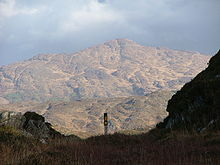Sheep's Head
Contributors to Wikimedia projects
 Article Images
Article Images
51°32′24″N 9°51′03″W / 51.54000°N 9.85083°W


Sheep's Head, also known as Muntervary (Irish: Rinn Mhuintir Bháire), is the headland at the end of the peninsula between Bantry Bay and Dunmanus Bay in County Cork, Ireland.
The Sheep's Head Way is an 88 km long-distance trail which follows old tracks and roads around the peninsula from Bantry to the headland and back. The trail is very accessible and is well signposted (see image on right). The route combines low and rugged hills with coastline and cliffs. The walkway is very straightforward and can be walked during any time between April and October.[1] The trail is divided into eight stages—each representing a half-day's walking. Among those responsible for establishing the Way were Tom Whitty, an American, and local farmer James O’Mahoney.
The peninsula has three villages, Durrus (six miles from Bantry), Ahakista (twelve miles from Bantry), and Kilcrohane (sixteen miles from Bantry)
Archaeology
Durrus
- Boulder Burial, Ballycomane
- Burial Ground, Brahalish, Clashadoo, Coolcoulaghta, Dunbeacon, Kilvenogue,
- Cairn, Coolcoulaghta, Moulinward
- Castle, Dunbeacon
- Church, Moulinward (In repair 1639 ruins 1699)
- Fulacht Fiadha (Cooking Pit), Dunbeacon, Celtic Iron Age 600 BC - 400 AD
- Graveyard, Moulinward
- Holy Well, Dunbeacon
- Mill Stone, Brahalish
- Promontory fort, Coolcoulaghta (Celtic Iron Age 600 BC - 400 AD)
- Ring forts, Ballycomane, Brahalish, Clonee, Drumtahaneen, Dunbeacon, Gortyalassa, Kealties, Rushineska,Celtic Iron Age 600 BC - 400 AD
- Shell Midden, Dunbeacon
- Standing Stones (Gallauns), Ballycomane, Coolcoulaghta (Stone Pair Bronze Age 2200-600BC, Kealties, Parkana)
- Stone Row, Moulinward,Bronze Age 2200-600BC
- Stone Circle, Dunbeacon (Bronze Age 2200-600BC) [1], [2]
- Tower House (medieval post 1200 AD), Rossmore (O'Mahony|McCarthy?)
Kilcrohane
- Ardahill, Ardintenant, Caher, Caheragh, Derrycluvane, Drumnea, Faunmore, Gortalassa, Gortaneish, Killoveenogue, Knockroe, Raferigeen, Letter East, Rossnacaheragh, Tullig Ringfort Celtic Iron Age 600 BC - 400 AD
- Aughaleigue, Gouladoo, Laherandota, Letter East, Holy well
- Ballytransna, Kilcrohane, Cashel
- Ardaneig, Caher, Farranamanagh, Gortnakilla, Killonoveenogue, Letter West, Kilcrohane, Burial Ground
- Caherurlagh, Holed Stone for healing
- Dooneen, Galladoo, Keelovenogue, Promontory Fort Celtic Iron Age 600 BC - 400 AD
- Dromnea, Bardic School Medieval post 1200 AD, Ornamental Tower erected Lord Bandon, Holy Well (tober na nduanairidhe well of the poets), possible fulach fiadh
- Farranmanagh, Stone Row Bronze Age, Children's Burial Ground, Souterrain, Tower house (O'Daly), Gallaun (standing stone
- Gouladoo, Holy Well
- Letter West, Children's Burial Ground
- Kilcrohane, Souterrain
- Signal Towers, Tooreen
Natural history
- Owen's Island c. 1 hectare
- Sheep's Head, Costal heathland includes rare plants Viola lactea (Pale Dog Violet), Tuberaria (Spotted Rock Rose) and also has choughs and fulmars
Bibliography
- Donald Grant (lived in Dooneen), White Goats and Black Bees. (Editions: New York: Doubleday, 1974 ISBN 0-385-06522-1; London: Joseph, 1975 ISBN 0-7181-1294-6; Schull: Mizen Books, 1990 ISBN 0-911797-86-6)
- Barry Keane: The Beara, Sheep's Head, and Mizen Peninsulas: 40 walks and scrambles. Cork: Collins Press, 1997. 87 p. ISBN 1-898256-29-2
- Wolfgang Keller: Off the beaten track: the Sheep's Head Way as an example of rural tourism in the South West of Ireland. University of Goettingen (Germany), 2003. 128 p. (Dipoloma thesis)
- Ann McCarthy: Under the Shadow of Seefin. 2001
- Frank O'Mahony: Kilcrohane. (Book 1: Kilcrohane - the Holy Ground—Book 2: O'Mahony - the diary of Frank). Dromkeal: Frank O'Mahony, 1990. 148 p.
- Westropp, Thomas Johnson: Fortified headlands and castles in western County Cork. Vol. 1: From Cape Clear to Dunmanus Bay. Dublin, 1915. (Proceedings of the Royal Irish Academy / C. Vol. 32, no. 17)
See also
References
External links
- Walk Ireland Official site of the Waymarked Ways of Ireland with map of Sheep's Head Way
- Guided hill walks on the Sheep's Head
- Awarded "EDEN - European Destinations of Excellence" non traditional tourist destination 2009